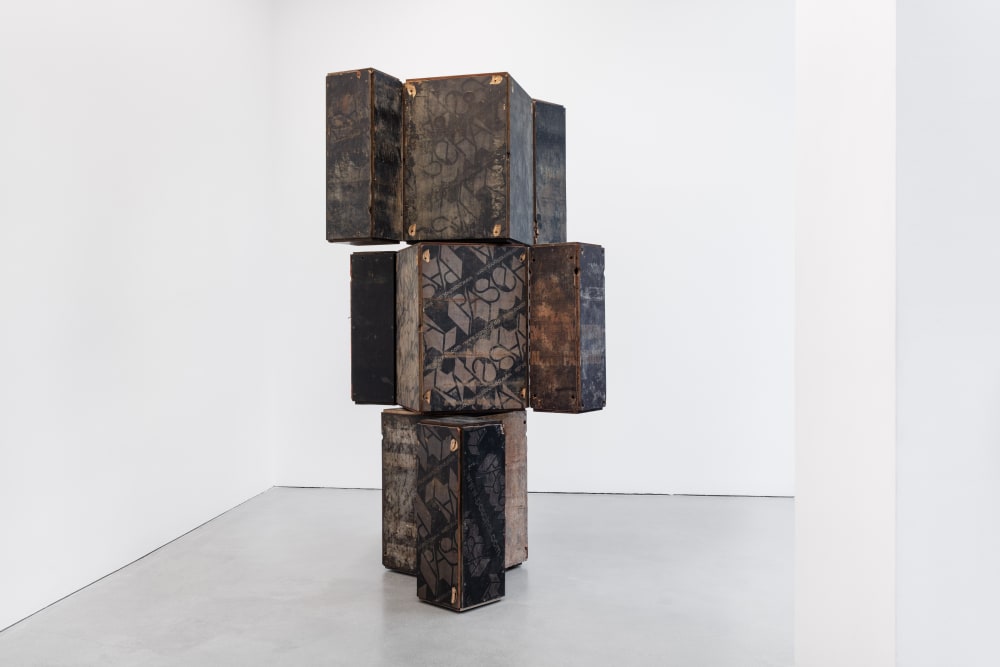BLINDTEXT : Franka Hörnschemeyer
-
介绍
At Galerie Thomas Schulte, Franka Hörnschemeyer presents her walk-in spatial sculpture Blindtext (2009), alongside a selection of drawings in the gallery’s Corner Space. The work’s overall structure takes the form of a hexagon, composed of aluminum honeycomb panels on top of a raised platform. Its labyrinthine internal system of doors and narrow passageways encloses and divides the space, as new ones are opened, altering the ways it is maneuvered and perceived.
Initially exhibited at Hamburger Kunsthalle, here, Blindtext brings another atmosphere through its interactions with the spatial registers of the gallery and its surroundings. The interwoven architectures of the tall display windows and the work’s vertical, reflective metal panels draw the viewers and interior space into interplay with passersby and the street outside. Oscillations are produced: between obstruction and seeing-through structural layers. The hexagonal form is echoed from the panels’ inner layer, glimpsed along the material’s edges, to the installation itself, and outward to the gallery’s exterior architecture—foregrounding the work as a space within a space. As it is navigated through and around from inside and out, there is a visible negotiation of spatial relationships that extends beyond its physical and material conditions. Reflections on the work’s moveable surfaces generate spectral impressions at times, as though in a state of dissolution—giving shape to the immaterial aspects that structure space.
In her work, Hörnschemeyer engages with the construction of space, not just materially, but also socially and historically. Here, the work’s hexagonal shape, like the honeycomb of a beehive, is one of symmetry, balance, and harmony, connected to notions of community, group formation and group mindedness. Its form is recurrent in the structures and patterns of natural and built environments—favored for its spatial and material efficiency, and, as in the panels used here, for providing stability based on mutual support. In Blindtext, these elements are set against feelings of ambivalence and unease induced by an interior that recalls a house of mirrors. The regularity of the geometric form is interrupted by the shifts and uncertainty within this system, which alternatingly affords structural clarity and opacity, mobility and its limitations. Elements that yield to movement, positioned in variable angles and relationships to one another, produce changing stratifications of material. The spaces that open up in between give a sense of porousness. While, from some perspectives, the structure might appear as a closed box—an impression that is reinforced by the aluminum honeycomb panels, which have insulating properties, teetering between protective and confining.
Hörnschemeyer works with found and recycled industrial materials that often underscore an ephemeral nature, even though they are ever-present in our surroundings. Such aluminum panels are not only used in architecture, but also in different forms of transport—suffusing them with a transient quality that is compounded by their lightweight portability. The materials she uses, which she considers important carriers of information, are also usually left in a raw, untreated state and in standard dimensions. Marks and traces are retained as the materials are transformed from one situation to another.
Presented here is also a series of translucent ink and pastel crayon drawings from 1988, in which we see Hörnschemeyer’s long-term considerations of space and material crystallized in another medium. The drawings are diptychs in which layering and separation simultaneously occur. One drawing in each comprises a loose rectangular form with clean black lines, the inside of which is smudged with blots, like a Rorschach. The second drawing in the set is a composite of a similarly defined frame, though not exact, inside of a more organic, amorphous spatial field. Between 1987 and 1988, Hörnschemeyer lived in New York, where she developed a deep and sustained interest in drywall, as a commonly, yet temporarily used material that seemed to be in constant motion, between construction and destruction. In these drawings, we might be reminded of the rugged edges of broken drywall, a hole in the wall that produces a new space, while revealing its underlying material structure. This material rawness—that which is concealed, but structures a space—is what, in the drawings, seems to extend from the rectangular frame, giving fluid form to the space beyond.
Blindtext (filler, or placeholder text) is something that holds place. Though graphically composed of familiar structures, it is made obtuse. Hörnschemeyer creates situations for materials, and for us, which bear a reflection of our built environment, disclosing information that is embedded within it, and at the same time contain their own inner workings to be deciphered. Within this system of relations, perception and understanding are activated through an experiential, physical engagement with how spaces are shaped and the ways in which they, in turn, shape us.
Text by Julianne Cordray
-
安装图示
-
作品
-
Inquire about works by Franka Hörnschemeyer

-
参展艺术家










